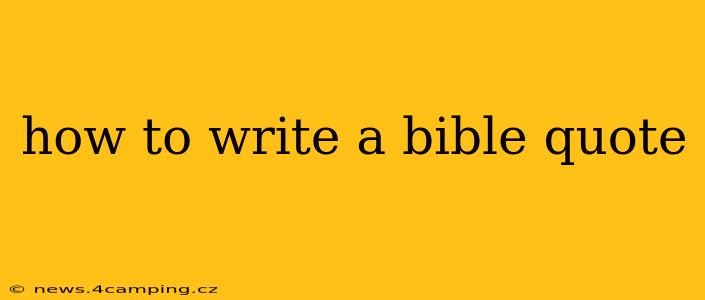How to Write a Bible Quote: A Guide for Accuracy and Clarity
Quoting scripture accurately and effectively is crucial for conveying meaning and avoiding misinterpretation. Whether you're writing a sermon, a theological paper, a blog post, or simply sharing a verse with a friend, understanding the best practices for quoting the Bible is essential. This guide will cover different styles and offer tips for clarity and context.
Which Bible Version Should I Use?
The first decision you'll need to make is which Bible translation to use. There are numerous versions available, each with its own strengths and weaknesses. Choosing a version depends on your audience and purpose. Some popular versions include:
- King James Version (KJV): Known for its literary beauty and traditional language, but can be challenging for modern readers.
- New International Version (NIV): A popular, widely understood translation that strives for accuracy and readability.
- English Standard Version (ESV): A more literal translation, aiming for accuracy while maintaining readability.
- New Living Translation (NLT): Focuses on readability and clarity, often paraphrasing for easier understanding.
Consider your audience's familiarity with biblical language when making your selection. For a general audience, a more modern translation like the NIV or NLT might be preferred. For academic purposes or when precise wording is crucial, the ESV or KJV might be more appropriate.
How to Format a Bible Quote:
Once you've chosen a version, follow these formatting guidelines:
- Direct Quote: Enclose the quote within quotation marks. For example: "Love your neighbor as yourself" (Matthew 22:39, NIV).
- Verse Reference: Always include the book, chapter, and verse number(s) in parentheses after the quote. Use a consistent abbreviation for the book (e.g., Gen for Genesis, Matt for Matthew). The version used should also be indicated, especially if using multiple versions.
- Multiple Verses: For multiple verses, use an en dash (–) to separate the verses. For example: "Blessed are the poor in spirit, for theirs is the kingdom of heaven. Blessed are those who mourn, for they will be comforted" (Matthew 5:3–4, NIV).
- Ellipses: Use ellipses (...) to indicate omitted words within a quote, but never use them to omit words that alter the meaning.
- Brackets: Use square brackets [ ] to add clarifying words or to correct grammatical errors within the quote. Be mindful of only adding necessary clarifications and never altering the original meaning.
- Italics: Some styles use italics for book names. Check your style guide.
How to Integrate Bible Quotes into Your Writing:
Don't just drop in quotes without context. Provide an introduction explaining the relevance of the quote to your point. After the quote, offer a brief explanation or analysis of its significance.
For example: "The Apostle Paul's words, 'Love is patient, love is kind' (1 Corinthians 13:4, NIV), beautifully encapsulate the essence of Christian love. This verse highlights not just an emotion but a deliberate action, a consistent commitment..."
What is the Best Way to Quote the Bible in a Paper?
In academic papers, always use a consistent citation style (e.g., MLA, Chicago). This usually involves footnotes or endnotes that provide full bibliographic information for the Bible version you used. Your university or publication will have specific guidelines.
What is the Best Way to Quote the Bible in a Sermon?
In sermons, aim for clarity and accessibility. You might speak the quote naturally, emphasizing key phrases. Providing the book and chapter may be sufficient, especially if your congregation is familiar with the text.
By following these guidelines, you can ensure your Bible quotes are accurate, clear, and effectively communicate the intended message. Remember, the goal is to convey the meaning of the scripture faithfully and meaningfully within your writing.
